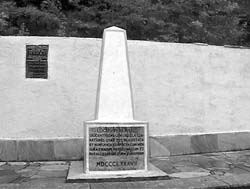Ukraine Divested of Geodetic Mark
Geographers have established that the center of Europe isn’t in Zakarpattia but in Vilnius
A geodetic mark indicating the center of Europe was set up 125 years ago near Dilove, a village in Rakhiv district, Zakarpattia. Experts from the French Institute of Geography recently took new measurements and determined that the geographic center of Europe is actually in the vicinity of Vilnius. The French Academy of Sciences has issued the Lithuanian government with an appropriate certificate.
Some Ukrainian scientists are inclined to accept this fact. Yuriy Karpinsky, who has a Ph.D. in Technical Sciences, even sent a letter to Deputy Premier Roman Bezsmertny. It reads in part: “Certain literary sources after WWII mistakenly placed the geographic center of Europe near the village of Dilove. This mistake is explained by an inaccurate translation of the Latin inscription carved in the stone pillar. What it actually means is, ‘This is a permanent, precise, and eternal place determined by a special device made in Austro-Hungary in 1887, using the European system of latitudes and longitudes.’ We know that some 20 similar stone pillars indicating the center of Europe were erected on the territory of Austro-Hungary.”
However, most Ukrainian experts categorically reject this approach and insist that Ukraine is indeed in the heart of Europe. A 35- year-old Carpathian biospheric preserve, encompassing 50,000 hectares protected by the state, is in charge of the geodetic mark near Dilove. To establish the truth, a continental geographic conference will be convened in Rakhiv in the nearest future. In 1887 geographers of the Austro-Hungarian defense ministry took measurements, and later a stone pillar with a Latin inscription appeared near Dilove, by the river Tisza. During a recent conference at the biospheric preserve, held jointly with Swiss colleagues to discuss the primordial Transcarpathian forests, the Swiss experts were asked to study archives in Vienna, London, and Budapest. Biologist Fedir Hamor, who is the director of the preserve, says that archival documents have been found in Vienna, indicating that the Kaiser Royal Institute of Military Geography in Hungary made appropriate land surveys and determined the geographic center. In 1977, a new metal geodetic mark was installed, indicating the center of Ukraine.
Dr. Hamor believes that the French researchers applied different Mendelevian methods to determine Europe’s center of gravity, according to which the coordinates crossed in Lithuania. Although the staff members of the biospheric preserve in Zakarpattia are treating this scientific debate philosophically, they have intensified their efforts to establish a business and educational Center of Europe near Dilove. A Carpathian Ecology Museum is already functioning. Soon an alley will appear, embellished by the national emblems of all countries on the continent, along with a concert square for holding festivals. Word has spread in the village, however, that the geodetic mark will be simply removed. Italian Ukrainians who have been living here since World War I were the first to voice their outrage. Their deputy, village chairperson Maria Coradini, plans to organize a European committee for the protection of the beacon during the international Hutsul festival in Rakhiv, if the encroachments on the mark do not cease.
Europe has once again begun to talk about Dilove and investors are sitting up. An Australian company has undertaken to study the Sauliak gold deposits. Several dozens of local workers are already working on the site. Three quarries have resumed operations, and the first tourist complex is under construction in the village. The project is coordinated by Yuriy Boiko, who was ashamed that the area, which he still believes is the heart of Europe, can’t accommodate the rising numbers of tourists. There is also a 200-year-old wooden church where Marko Barabolia, a noted Transcarpathian satirical writer, was baptized. Oleksa Dovbush also visited the church with his bands of brigands, the opryshky. Artist Ihor Lutsenko boasts a rich collection of antiquities in his Dyvo Cafe, where no alcoholic drinks are served on principle.
The Transcarpathian authorities have decided to put this upsurge of scientific debate focusing on the geographic center of Europe to pragmatic use. They have contacted President Yushchenko, who is known to start his annual climb to Mt. Hoverla at the geodetic mark near Dilove, asking the cabinet to finally build a direct railroad from Kyiv to Rakhiv. After all, the Transcarpathian Railroad, which in its time linked Halychyna with Budapest and Bucharest, passes through here.






